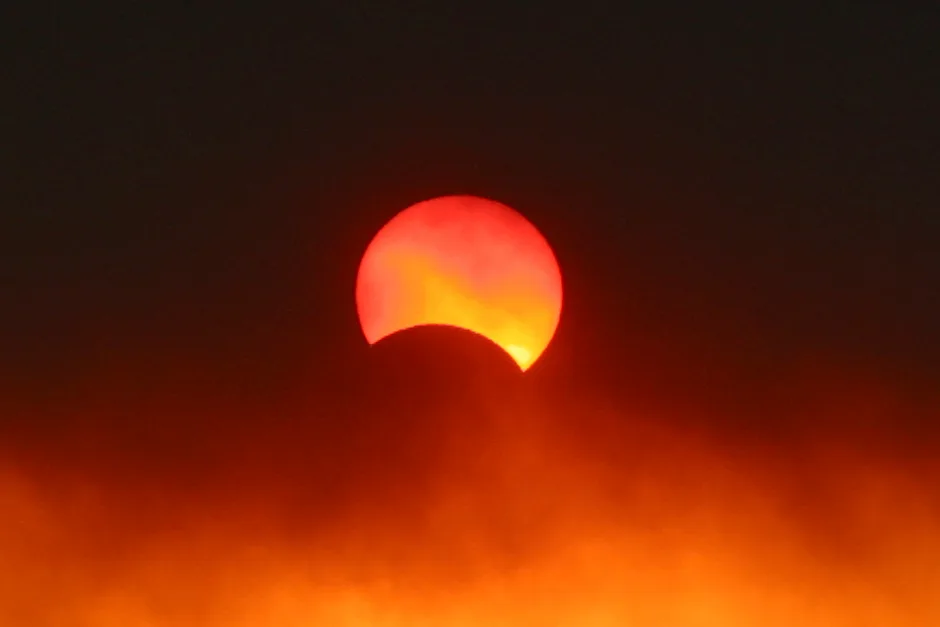
A partial solar eclipse is set to grace the skies this weekend, but weather conditions may hinder visibility for many eager skywatchers. While some regions will face cloud cover and precipitation, others have a fair chance—between 40 to 60 percent—of catching a glimpse of this celestial event.
Cloudy Skies May Obstruct Views in the Northeast
For those in New York State, New England, and Atlantic Canada, weather conditions may pose a significant challenge. A stationary weather system is expected to generate widespread cloud cover and precipitation, including rain, sleet, and even snow in some areas.
A series of low-pressure systems moving along this front will contribute to these unsettled conditions. Northern New York State and central New England will experience temperatures in the 30s and 40s, while southern New England, New York, New Jersey, and Pennsylvania will see significantly warmer conditions, with highs reaching the 70s and 80s.
Prospective eclipse watchers venturing to northern New York, Vermont, New Hampshire, and parts of Maine may need to bring more than telescopes and solar filters—a snow shovel might be necessary, as up to four inches of snow could be on the ground at eclipse time. Further south, precipitation will transition to sleet and light rain, potentially obscuring the view.
Where to Find the Best Viewing Spots
Despite the widespread cloudiness, certain locations still have a decent chance of catching the eclipse. The northern half of Aroostook County, Maine, could be just far enough north to escape the thickest clouds, offering at least partial visibility. Similarly, northern New Brunswick and areas north of Quebec City may see favorable conditions.
In contrast, much of Nova Scotia, Prince Edward Island, and Newfoundland will likely be under heavy cloud cover. However, some regions, such as Nova Scotia’s Minas Basin and Eastern Shore, might experience breaks in the clouds, providing occasional glimpses of the event. For those fortunate enough to witness it, the eclipse will offer a dramatic scene, with up to 80 percent of the sun’s disk obscured by the moon.
Southern Regions Face Uncertainty
For skywatchers in southern New England and southeastern New York, visibility will depend on whether low cloud cover breaks in time for the eclipse. Given that the event will conclude within half an hour of sunrise, there’s a risk that the sun may remain obscured until after the eclipse ends.
Further south, in Pennsylvania, New Jersey, and the Delmarva Peninsula, the forecast is more promising. These areas should experience partly to mostly sunny skies, though the eclipse itself will be less dramatic, with only a small portion of the sun covered.
Staying Updated on Weather Conditions
Given the variability in weather conditions, it’s crucial to check for real-time updates before heading out to observe the eclipse. NOAA offers detailed local forecasts through its National Weather Service Forecast Offices, while Environment Canada provides similar updates for Canadian viewers.
The Unusual Twilight Effect
Partial solar eclipses typically receive little attention, but this one is noteworthy due to its timing. Over parts of Canada and northern New England, the eclipse will coincide with sunrise, potentially creating an eerie twilight effect. If skies are clear, observers may notice an unusual dimming or a yellowish hue in the landscape as the sun rises with a large portion of its disk obscured.
For those in locations where maximum eclipse coverage exceeds 80 percent—such as eastern Maine, eastern Quebec, and parts of Atlantic Canada—the reduced sunlight might not drastically darken the environment but could still alter the quality of light, creating a rare and striking visual phenomenon.
Safety First: Protect Your Eyes
As with all solar eclipses, proper eye protection is essential. Even when the sun appears dimmed by haze or low on the horizon, its infrared rays can still cause permanent eye damage. Use solar eclipse glasses or certified solar filters when viewing through telescopes or binoculars. A pinhole projector is also a safe and easy alternative for indirect viewing.
While partial eclipses don’t match the spectacle of total eclipses, they remain fascinating events. This sunrise eclipse, with its potential for dramatic lighting effects, is particularly worth observing—if weather permits.
For those unable to watch in person, multiple livestreams will broadcast the event, ensuring that everyone can experience the wonder of the eclipse from the comfort of their home. Stay tuned for real-time updates and enjoy the show!